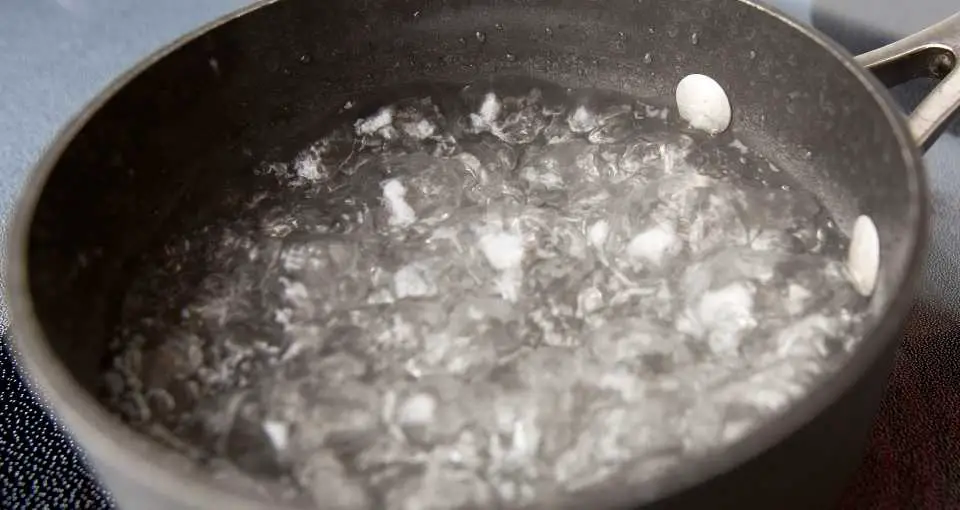We all boil water, be it in a kettle, a pot, or even a pan. But do we ever think about the container we’re using? Especially if it’s a non-stick pan. Is it okay to boil water in a non-stick pan? And what do I do to boil the water?
It is okay to boil water in all modern non-stick pans. The 100°C boiling point of water is below the temperature where the PTFE in the coating of Teflon coated pans break down, and all modern non-stick-coated pans accommodate this.
Is that all there is to boiling water in a non-stick pan, or are the other considerations that should take into consideration?
Is it safe to boil water on a stovetop using a non-stick pan?
If you’ve never boiled water in a non-stick pan before but now need to, follow this step-by-step process, it’s relatively easy.
If you use a gas stovetop to boil water in a non-stick pan, you need to
- Select the gas burner you’d like to use and turn it to a medium to high setting.
- Fill your non-stick pan with the desired amount of water.
- Place your water-filled pan on the burner.
- If you have a non-stick pan lid, place it on the pan.
- The water will begin to boil within four minutes, and when it does, switch the burner off.
- Carefully remove the lid of the pan away from you with the use of a potholder. Be cautious as the steam from the pan can burn.
- If you don’t have a lid for the non-stick pan, heat the water in your pan as if you have a cover. The water will now take a few minutes more to boil.
- Once the water is boiling, transfer it to whatever you need to place it in.
If you use an electric stove to boil water in a non-stick pan, you need to
- Bringing water to boil on an electric stovetop is almost the same as using a gas stovetop, although it will take three to four minutes longer for the water to boil.
- Follow the same steps as if you were using a gas hob, but be careful around the burner you use.
- An electric burner glows red hot when used and changes back to its original color quickly after being switched off.
- Because the burner is no longer red doesn’t mean it’s not hot.
- For safety’s sake, please avoid contact with the burner until it’s completely cooled.
Twelve awkward questions are answered.
- Can you boil water in a non-stick pan on direct heat?
- Non-stick cookware is not designed to withstand very high heat.
- The higher temperatures, especially the direct heat of a flame, will damage the non-stick pan coating over time.
- Direct heat can break down the coating of the pan and cause the release of harmful toxins.
- Can I boil water in a scratched non-stick pan?
- Ideally, you shouldn’t be boiling water in a scratched non-stick pan. If that is all you have to boil water in, try fixing your pan.
- Apply coconut oil all over the pans non-stick coating.
- Heat the pan on the medium-high setting, then wait for the pan to cool.
- Wipe clean with a dry microfiber cloth.
- This process will fix the scratches and give your pan a longer life span.
- Are there any health issues in boiling water in a non-stick pan?
- Non-stick pans of today won’t be affected by boiling water. The only time it may is if all the water in the pan has boiled away.
- Damage to non-stick pans comes from leaving them on the burner too long, taking a hot pan off the burner, and putting it in cool water.
- Almost all non-stick pans sold in the US are safe to use for boiling water and don’t outgas dangerous vapors.
However, if your non-stick pan is over ten years old, seriously look at replacing it.
- Getting a pan with a reasonable thickness helps conduct heat well through the entire pan.
- If you were to heat the pan before putting the water in it, you might end up deforming the pan and making the coating flake.
- Can you boil water more than once in a non-stick pan?
- Boiling water more than once doesn’t present any risk, both to the pan or one’s health.
- If you re-boil the same water, make sure it’s pure, distilled, and deionized water.
- If you boil regular tap water over and over, you risk a build-up of contaminants and minerals found in tap water.
- Make it standard practice to change the water in your non-stick pan after every use.
- Is using a non-stick pan an efficient way to boil water?
An electric kettle is about 80 percent efficient. Electric kettles are well insulated, and the heating coils sit directly in the water; this way, less heat is lost to the air. An induction stove or hot plate is about 85 percent efficient.
- Can you spoil the water in a non-stick pan?
Water will never get hotter than 100°C, and today’s makes of non-stick pans can accommodate temperatures of up to 300°C.
- Do you heat your non-stick pan before you put the water in it?
These are two good reasons why you shouldn’t pre-heat a non-stick pan.
- There’s more of a chance of someone grabbing an empty pan than a pan that has something in it. If the pan’s hot, an ugly burn accident could occur.
- Pre-heating a non-stick pan can warp it and destroy the non-stick coating.
- Can I boil water in a Teflon-based non-stick pan?
Today’s Teflon non-stick pans are made with safe and stable compounds. However, at temperatures above 300°C, Teflon coatings on non-stick cookware start to break down, releasing toxic chemicals into the air. Inhaling these fumes know as Teflon flu, may lead to polymer fume fever. - How come it takes longer for water to boil in a non-stick pan than in a regular pan?
Boiling water in a non-stick pan requires more time than traditional pots and pans. Non-stick pans retard heat. Thus, boiling water in the pan takes longer than a regular pan.
- When shouldn’t I boil water in a non-stick pan?
When pans are scratched or chipped, some of the non-stick coatings can flake into the water. When this happens, toxic compounds are released. With moderate use, non-stick pans last only about five years. If your pan is damaged, it’s better to get rid of it for safety reasons.
- How long will my non-stick pans last if I only boil water in them?
A looked after non-stick pan will last about five years. If it appears to warp, discolor, or scratch in any way, stop using the pan.
- Are all non-stick pans safe for boiling water?
Many health agencies have raised concerns about the coating compounds used to produce non-stick pans. Today’s non-stick pans are safe to use for everyday home cooking, so long as temperatures don’t exceed 300°C.
The pros and cons of boiling water in a non-stick pan
Pros:
- Easily washes with soapy water
- It’s non-stick
- Lightweight cookware
Cons:
- Surfaces can scratch, chip and flake as pans get older. Scratches and chips become more extensive, leaving tiny shards of Teflon in the water.
- The pans may stain
- Pan warps under thermal shock (overheating an empty pan, dunking a hot pan into cold water, or placing a hot pan onto a cold surface.)
Final thoughts
You can safely boil water in a non-stick pan. Although, specific steps should be followed when using an electric or a gas stovetop when boiling the water.
- Water comes to a boil faster with a lid, but be careful of steam burns when removing the top from your pan.
- The pan must have no chips or scratches and must not be subjected to high temperatures.
- Don’t run cold water over a hot non-stick pan; this may induce thermal shock, and the pan’s coating could be compromised.
- Don’t clean your non-stick pan by using metal spatulas, scrub brushes, and dishwashers.

